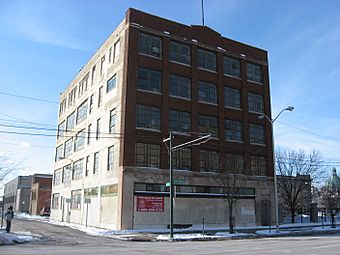Graphic Arts Building (Dayton, Ohio) facts for kids
Quick facts for kids |
|
|
Graphic Arts Building
|
|

Front and southern side of the building
|
|
| Location | 221-223 S. Ludlow St., Dayton, Ohio |
|---|---|
| Area | Less than 1 acre (0.40 ha) |
| Built | 1924 |
| Architect | Harry I. Schenck; Harry J. Williams |
| Architectural style | Early Commercial |
| NRHP reference No. | 09000911 |
| Added to NRHP | November 12, 2009 |
The Graphic Arts Building is a special old building in Dayton, Ohio, United States. It's located right on the edge of the city's downtown area. This building was constructed in the 1920s. For many years, it was home to a company that published books and newspapers for a Christian church group. Because of its history and unique design, the Graphic Arts Building is now recognized as a historic site.
Contents
A Place for Publishing
The Christian Publishing Association
The story of the Graphic Arts Building is closely linked to a group called the Ohio Christian Book Association. This group started way back in 1843. They were a publishing company connected to a church group known as the Christian Connexion. This church group is actually one of the older parts of today's United Church of Christ.
The Christian Connexion was part of a larger religious movement. They supported the printing of a newspaper called the Herald of Gospel Liberty. Some people say this newspaper was the oldest religious newspaper in the world!
Early Publishing Homes
Starting in 1868, the Christian Publishing Association began printing this newspaper. At that time, they bought a building in downtown Dayton. However, they soon found that building wasn't quite right for their needs. So, after more than ten years of working from rented spaces, the association bought a new piece of land. They paid $28,000 for it.
Construction on a new building began quickly. By the time it was finished in June 1905, over $100,000 had been spent on the building and its equipment.
The Graphic Arts Building's Role
About twenty years later, the association decided to build the Graphic Arts Building we see today. This building is located on Ludlow Street. The Christian Publishing Association only used this building for eleven years. They moved out in 1936.
Building Design
Who Designed It?
The Graphic Arts Building was designed by a famous architectural company from Dayton called Schenck & Williams. They created a very strong and unique building.
Materials Used
The building is made from several different materials. Its base, or foundation, is made of concrete. The roof is covered with asphalt. The main walls are a mix of brick, concrete, and glass. For extra details, they used beautiful materials like marble, limestone, and other types of stone.
Strong and Safe Design
A lot of concrete was used in the building's construction. This was very important! It was needed to support the heavy weight of the company's printing machinery and all the materials they stored. Using concrete also made the five-story building fireproof, which was a great safety feature.
The sides of the building don't have many windows. But the front of the building is different. It has five big windows on each floor above the ground level. These large windows were put there to let in lots of natural sunlight, which was important for the workers inside.
Protecting History
Becoming a Historic Site
In August 2009, a group called the Ohio State Historic Preservation Office suggested that the Graphic Arts Building should be added to the National Register of Historic Places. This register lists important historical places across the United States.
At first, the building's owner didn't want it to be named a historic site. But within a few months, he changed his mind. So, in November 2009, the Graphic Arts Building was officially added to the National Register.
Why It's Important
The building earned this special recognition for two main reasons:
- Its architecture is historically important and unique.
- It played a significant part in the local history of Dayton.
Interestingly, the Christian Publishing Association's previous building also has a historical connection. That building, located at Fifth and Ludlow, is now called the Hamiel Building. It's part of a larger area known as the Dayton Terra-Cotta Historic District, which is also listed on the National Register of Historic Places.
See also
 In Spanish: Graphic Arts Building (Dayton, Ohio) para niños
In Spanish: Graphic Arts Building (Dayton, Ohio) para niños



